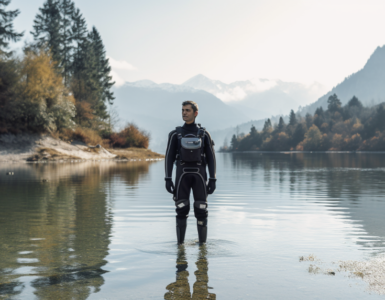Have you ever wondered how wetsuits keep us warm while we’re splashing around in the cool waters during our favorite water sports? If you’re an enthusiast of water sports, understanding how your gear works can not only improve your performance but also ensure your safety. In this blog post, we’re going to demystify the science behind wetsuits. We’ll discuss the materials used, how the design provides insulation, and why they are so important for water sports.
The Basic Material of Wetsuits
The primary material used in the manufacturing of wetsuits is neoprene. This synthetic rubber is known for its incredible flexibility, durability, and buoyancy. But why neoprene, you might ask? Well, it’s these unique properties that make it an ideal choice for wetsuits. Its flexibility allows for a wide range of movement, its durability ensures it withstands the harsh oceanic conditions, and its buoyancy aids in keeping the wearer afloat.
The Science behind Wetsuits
Now that we’ve talked about the material, let’s delve into the science of how wetsuits work. The key lies in insulation and heat retention. Wetsuits work on a simple principle – they trap a thin layer of water between the suit and your skin. Your body heat warms this water, creating an insulating layer that helps retain your body heat. So, instead of feeling the chill of the water, you’re kept warm by this heated layer. Pretty cool, right?
Types of Wetsuits
Did you know that there are different types of wetsuits designed for various water temperatures and activities? Yes, it’s true! They include spring suits, full suits, farmer johns/janes, and dive suits. Each type of wetsuit has its unique features and advantages. Let’s take a closer look.
Spring suits
Ever wondered what type of wetsuit is ideal for warmer water temperatures? It’s the spring suit. These suits typically have short legs and short or long sleeves. They are designed to provide a balance between warmth and freedom of movement. So, if you plan on engaging in water sports during warmer weather, spring suits might be your best bet.
Full suits
For those planning to venture into colder waters, full suits are the way to go. These wetsuits cover the entire body, including arms and legs, providing maximum thermal protection. They are thicker than spring suits, which is crucial in maintaining body heat. Isn’t it fascinating how different designs cater to varying water temperatures?
Understanding Wetsuit Thickness
Speaking of thickness, did you know wetsuits are categorized by their thickness? The thickness of a wetsuit directly relates to the water temperature and the duration you plan to stay in the water. The thicker the wetsuit, the warmer you’ll stay. But there’s more to it!
| Wetsuit Thickness | Suitable Water Temperature |
|---|---|
| 0.5 – 2 mm | Warm: 20°C and above |
| 2 – 3 mm | Mild: 17°C – 20°C |
| 3 – 4 mm | Cool: 14°C – 17°C |
| 4 – 5 mm | Cold: 9°C – 14°C |
| 5 mm and above | Freezing: Below 9°C |
Wetsuits for Different Water Sports
Just as there are different types of wetsuits for various water temperatures, there are also special wetsuits designed for specific water sports. These include surfing, diving, and water skiing, among others. For instance, surfing wetsuits are more flexible around the arms to allow for paddling. In contrast, diving wetsuits are generally thicker for deeper, colder waters. Amazing, isn’t it, how the design of a wetsuit can significantly impact your performance in water sports?
The Importance of a Proper Wetsuit Fit
Ever wondered why professional divers and surfers seem so comfortable in their wetsuits? It’s not just because they’re used to it; a proper wetsuit fit plays a significant role too. Let’s emphasize this – the fit of your wetsuit is crucial for both your performance and safety during water sports.
Imagine wearing a wetsuit that’s too tight. It would restrict your movement, making it difficult to swim freely. Or what if your wetsuit is too loose? It might allow cold water to sneak in, defeating the purpose of insulation. So, it’s clear that getting the right fit is non-negotiable.
How to Choose the Right Wetsuit
Now that we understand how important the fit is, let’s dive into how you can choose the right wetsuit for your water sports needs. After all, isn’t it better to make an informed decision rather than regret later?
There are several factors you need to consider while choosing your wetsuit. These include the water temperature, the type of activity you’ll be doing, and of course, your personal comfort. It’s not just about picking the thickest or most expensive one; it’s about finding the right balance that suits your specific needs.
- Water Temperature: The temperature of the water you’ll be in determines the thickness of the wetsuit you need. Cold waters require thicker wetsuits for better insulation.
- Type of Activity: Are you going to surf, dive, or ski? Different water sports require different types of wetsuits. For example, surfers might need more flexible wetsuits for easy movement.
- Personal Comfort: Never underestimate the importance of comfort. Even if a wetsuit checks all other boxes, if it doesn’t feel comfortable, it’s not the right one for you.
Remember, the right wetsuit isn’t just about keeping you warm; it’s about enhancing your performance and ensuring safety while you enjoy your favorite water sports.
Cleaning and Maintaining Your Wetsuit
Ever wondered why your wetsuit doesn’t last as long as you expected? Well, the secret to prolonging its lifespan lies in how you clean and store it. Proper cleaning and storage not only keep your wetsuit in good condition but also ensure its functionality and durability over time.
Like any other sports gear, wetsuits require some TLC. So, how do you go about cleaning and storing your wetsuit? Let’s find out.
A Step-by-Step Guide on How to Properly Clean and Store Your Wetsuit:
- Rinse it thoroughly: As soon as you’re out of the water, rinse your wetsuit with fresh water. This helps remove salt, sand, or any other particles that could damage the neoprene.
- Wash it carefully: Use a mild detergent and gently clean your wetsuit. Avoid harsh chemicals, as they can degrade the material.
- Dry it properly: After washing, let your wetsuit dry in a well-ventilated area. Avoid direct sunlight as it can cause the neoprene to become brittle.
- Store it correctly: Once dry, store your wetsuit in a cool, dry place. Hanging it on a wide hanger can help maintain its shape.
Conclusion: Making the Most of Your Wetsuit
And there you have it! We’ve unlocked the mystery of how wetsuits work, explored their different types and thicknesses, emphasized the importance of a proper fit, and walked you through the process of cleaning and maintaining your wetsuit. It’s quite a journey, isn’t it?
Understanding these aspects not only helps you make an informed purchase but also ensures you get the most out of your wetsuit. Whether you’re surfing the waves, diving into the deep, or water skiing, the right wetsuit can make all the difference.
So, ready to hit the water with your well-maintained wetsuit? We bet you are! Enjoy your water sports activities and remember – a well-cared-for wetsuit is a long-lasting wetsuit.




